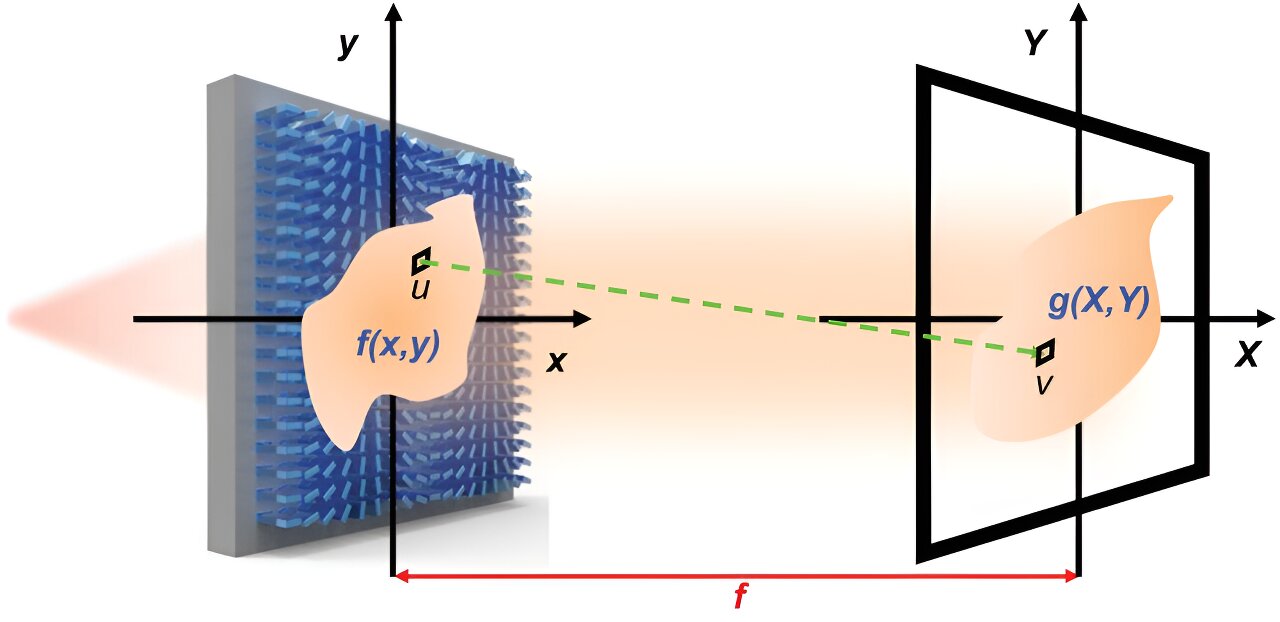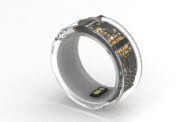
via Phys.org
On a cold, sunny day, you’re driving on a rural road, surrounded by snow-covered fields. In an instant, your eyes process the scene, picking out individual objects to focus on — a stop sign, a barn — while the rest of the scene blurs in the periphery. Your brain stores the focused and blurred images as a memory that can be pictured in your mind later, while sitting at your desk.
Mimicking this easy, instantaneous image processing power of the human eye, Penn State electrical engineering researchers created a metasurface: an optical element akin to a glass slide that uses tiny nanostructures placed at different angles to control light. Led by corresponding author Xingjie Ni, associate professor of electrical engineering and computer science (EECS) at Penn State, the team published their invention in Nature Communications.
Artificial intelligence (AI) systems require significant computing power and energy and can be slow to process images and identify objects, according to the researchers. By contrast, the metasurface can be used to preprocess and transform images before they are captured by a camera, allowing a computer — and AI — to process them with minimal power and data bandwidth.
The metasurface works by converting an image from the Cartesian coordinate system, where image pixels are arranged in straight rows and columns along the x and y axes, to the log-polar system, which uses a bullseye-like pixel distribution.
“Like the arrangement of light receptors inside the human eye, the metasurface takes images and arranges them in a log-polar coordinate system — with denser pixels for the central, focused features and sparser pixels for the peripheral regions,” Ni said. “This allows for the more important aspects of a photo to come through clearly while others remain less in focus, thereby saving data bandwidth.”
The metasurface is placed in front of a camera so that light first passes through it and transforms the image from the Cartesian system into log-polar coordinates before it is digitalized by a camera and transferred to a computer. Since it works using nanostructures that bend light, the metasurface does not need any power and works at the speed of light.
“As an image of an object can vary in size or orientation, it is desirable to preprocess images to make them resistant to scale and rotation changes,” Ni said. “This preprocessing helps AI applications more easily recognize them as the same object.”
By placing a different metasurface in front of a camera, researchers also can transform the log-polar image back into the original image with Cartesian coordinates.
The invention has many potential applications, the researchers said, including for use in target tracking and surveillance to map how a car, for example, moves across a city.
“A metasurface can be used in tandem with AI systems as a preprocessor, making it easier to recognize the same car from multiple street view cameras,” Ni said. “Or if it is applied to a satellite, it could potentially track planes from takeoff to landing.”
Original Article: Optical invention mirrors the image processing power of a human eye
More from: Pennsylvania State University
The Latest Updates from Bing News
Go deeper with Bing News on:
Image processing
- Global Image Recognition Market Insights and Outlook to 2029: QR/Barcode Recognition to Dominate in 2024
Image recognition technology seamlessly integrates with existing workflow systems and document management platforms. Integrating with scanning devices, document repositories, and business applications ...
- Image processing articles from across Nature Portfolio
Image processing is manipulation of an image that has been digitised and uploaded into a computer. Software programs modify the image to make it more useful, and can for example be used to enable ...
- Playboy image from 1972 gets ban from IEEE computer journals
has been used in image processing research since 1973 and has attracted criticism for making some women feel unwelcome in the field. In an email from the IEEE Computer Society sent to members on ...
- Top 10 Best Image Processing Libraries in Python in 2024
Python is a preferred programming language for image processing, thanks to its broad selection of libraries that accommodate various image processing activities. This article will explore some of ...
- A Real-Time Image Processing with a Compact FPGA-Based Architecture
Furthermore, in image processing related to quality control applications where the inspection has to be accurate, it is difficult to analyze the information of an image directly from the gray-level ...
Go deeper with Bing News on:
Metasurface
- South Korean Scientists Develop Innovative Anti-Counterfeiting ‘Smart Labeling’ Technology
SEOUL, Apr. 26 (Korea Bizwire) – A groundbreaking new labeling technology that prevents forgery and counterfeiting by engraving information instead of using adhesive stickers has been developed by a ...
- New metasurface innovation unlocks precision control in wireless signals
Researchers have unveiled a technology that propels the field of wireless communication forward. This cutting-edge design, termed a reconfigurable transmissive metasurface, utilizes a synergistic ...
- Newmetasurface innovation unlocks precision control in wireless signals
This cutting-edge design, termed a reconfigurable transmissive metasurface, utilizes a synergistic blend of scissor and rotation actuators to independently manage beam scanning and polarization ...
- New metasurface innovation unlocks precision control in wireless signals
Researchers from Chung-Ang University have developed a metasurface that addresses prevailing limitations by offering independent manipulation of beam direction and polarization state. Published in ...
- Gigahertz-rate switchable wavefront shaping by LNOI-empowered metasurface
Over the past decade, metasurfaces deploying two-dimensional artificial nanostructures have emerged as a groundbreaking platform to manipulate light across various degrees of freedom. These ...







